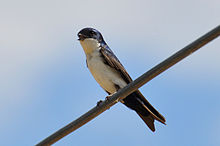- Blue-and-white Swallow
-
Blue-and-white Swallow 
In Rio Grande do Sul, Brazil Scientific classification Kingdom: Animalia Phylum: Chordata Class: Aves Order: Passeriformes Family: Hirundinidae Genus: Notiochelidon Species: N. cyanoleuca Binomial name Notiochelidon cyanoleuca
(Vieillot, 1817)Synonyms Hirundo cyanoleuca Vieillot, 1817
Pygochelidon cyanoleuca (Vieillot, 1817)The Blue-and-white Swallow (Notiochelidon cyanoleuca) is a passerine bird that breeds from Nicaragua south throughout South America, except in the deserts and the Amazon Basin. The southern race is migratory, wintering as far north as Trinidad, where it is a regular visitor. The nominate northern race may have bred on that island.[1]
Sometimes placed in the genus Pygochelidon,[2] it was first formally described as Hirundo cyanoleuca by French ornithologist Louis Vieillot in 1817, based on a specimen he believed to be from Paraguay.[3] The scientific names mean the same as the English common name.
Description
The adult Blue-and-white Swallow averages 11–12 cm long and weighs about 10g. It has dark blue upperparts and white underparts, and its underwings and the undersurface of its short forked tail are blackish. The juvenile is brown above, buff-tinted below, and has a less forked tail. The call is a buzzing dzzzhreeee.[4]
There are three subspecies. The nominate N. c. cyanoleuca occurs from Nicaragua and Trinidad south to northwestern Argentina, Paraguay and Uruguay. The migratory southern race N. c. patagonica is larger (13.5 cm), has paler underwings, and white basal undertail coverts. N. c. peruviana is restricted to coastal Peru up to 2500 m altitude. It is smaller than patagonica, has less white in the undertail, darker underwings and duskier flanks.[4]
Ecology
This is a swallow of open areas including villages and towns, farms, and forest clearings. In Central America it is a highland bird, but elsewhere in its range it can occur from the lowlands to an altitude of 4000 m.[5]
This species is often found in small flocks when not breeding. The Blue-and-white Swallow subsists primarily on a diet of insects, caught in the air; they have been seen to gather where termites swarm.[6] The flight is typically fluttery, and this swallow frequently perches on wires or branches.[4]
The Blue-and-white Swallow's shallow straw nest is built by both adults in a wide range of natural or man-made cavities include tree holes, rock crevices and bridges. The clutch is up to six white eggs in the south of the range, two or three in the north, which are incubated by both parents for 15 days to hatching. The nestlings are fed by both parents for 26 days to fledging, bur return to the nest to sleep with the parents for up to two months. There may be two broods.[4]
This common and popular species has benefited greatly from deforestration and human settlement which have increased the amount of suitable habitat and food that helps the bird greatly.[4] Consequently, it is not considered threatened by the IUCN.[7]
Footnotes
References
- BirdLife International (BLI) (2004). Pygochelidon cyanoleuca. 2006. IUCN Red List of Threatened Species. IUCN 2006. www.iucnredlist.org. Retrieved on 02 October 2008.
- ffrench, Richard; O'Neill, John Patton & Eckelberry, Don R. (1991): A guide to the birds of Trinidad and Tobago (2nd ed.). Comstock Publishing, Ithaca, N.Y. ISBN 0-8014-9792-2
- Olson, Storrs L. & Alvarenga, Herculano M. F. (2006): An extraordinary feeding assemblage of birds at a termite swarm in the Serra da Mantiqueira, São Paulo, Brazil. Revista Brasileira de Ornitologia 14 (3): 297–299 [English with Portuguese abstract]. PDF fulltext
- Stiles, F. Gary & Skutch, Alexander Frank (1989): A guide to the birds of Costa Rica. Comistock, Ithaca. ISBN 0-8014-9600-4
- Turner, Angela & Rose, Chris (1989): Swallows and martins: an identification guide and handbook. Houghton Mifflin. ISBN 0-395-51174-7
- Vieillot, Louis Jean Pierre (1817): Nouveau Dictionnaire d'Histoire Naturelle (nouvelle ed., vol. 14).
External links
- Blue-and-white Swallow videos, photos & sounds on the Internet Bird Collection
Swallows (family: Hirundinidae) River martins (subfamily: Pseudochelidoninae • genus: Pseudochelidon) All other swallows and martins (subfamily: Hirundininae) Psalidoprocne
(saw-wings)PseudhirundoRiparia
(sand martins)Tachycineta
(tree swallows)HaplochelidonNeochelidonAlopochelidonHirundo
(barn swallows)Ptyonoprogne
(crag martins)Delichon
(house martins)Categories:- Notiochelidon
- Birds of Nicaragua
- Birds of Panama
- Birds of South America
- Birds of Trinidad and Tobago
Wikimedia Foundation. 2010.
